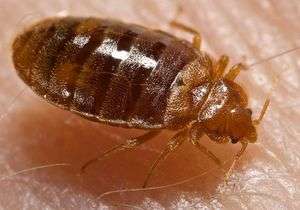Bed bugs
Background
- Cimex lenticularis
- Bed bug bites are known as 'cimicosis'
- Bed bugs are attracted to CO2, warmth, exposed surfaces
- Tend to hide near beds, cracks, crevices
- Feed at night
- May appear translucent (nymphs,) brown (mature bug,) red (after meal,) black (after digestion)
- Belong to Hemiptera (like kissing bugs) which are vectors for trypanosomiasis (Central and South America)
Clinical Features

Bed bug

Bedbug with classic hemmoragic appearance and punctate center
- Up to 20% of patients do not experience symptoms[1]
- Pain immediately after bite
- Erythematous papules, bullae, and wheals may take days to develop
- Classic line of bites: "breakfast, lunch, and dinner"
Differential Diagnosis
Domestic U.S. Ectoparasites
- Bed bugs
- Lice
- Scabies (Mites)
- Ticks
- Fleas
- Pseudoparasites
- Delusional parasitosis (Ekbom syndrome)
See also travel-related skin conditions
Evaluation
- Clinical diagnosis, based on history and physical exam.
Management
- Primarily supportive care
- Antihistamine for pruritus
- Consider topical steroids to decrease inflammation
- No evidence that medications improve outcomes
- Treat systemic reactions similar to anaphylaxis (rare)
- Self-limited 1-2 weeks without treatment
- Eradication using pesticides, hot water washing of bedding
Disposition
- Discharge if no evidence of systemic symptoms or anaphylaxis
See Also
External Links
References
- Jerome Goddard & Richard deShazo (2009). "Bed bugs (Cimex lectularius) and clinical consequences of their bites". Journal of the American Medical Association 301 (13): 1358–1366. PMID 19336711.
This article is issued from
Wikem.
The text is licensed under Creative
Commons - Attribution - Sharealike.
Additional terms may apply for the media files.